Just when you thought tech was hitting peak techitude, with near-supercomputers modestly called “smartphones” fitting into your shirt pocket, along comes—the fidget spinner! No processor, no RAM, no Bluetooth. We’re back to the basics of ball-bearings, and that’s it.
The origin of the fidget spinner is a sweet-sour fairytale (see below). A related device, climbing on the shoulders of the fidget spinner’s success, has a comparable roller-coaster history. This is the Fidget Cube, a device that was born out of a Kickstarter project. The initial funding request for $15,000 flooded the coffers with something little short of $6.5 million.
And that’s where the roller-coaster started to dive…
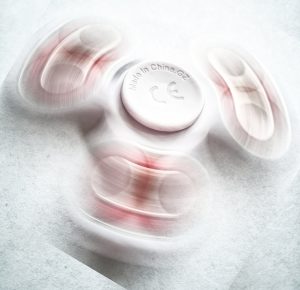
Thanks to its high-quality ball-race, this Zuru version of the fidget spinner will keep going on its own for well over two minutes
Lost Fortune?
BY NOW WE MUST ALL be familiar with the fidget spinner—the (usually) three-winged device rotating around a central ball-race that can be flicked into action with a spare digit while being held in the middle between finger and thumb.
That, essentially, is all the device ever does, although on YouTube you’ll find some basic variants, some (jokey) “lifestyle” manoevres, and even some magic tricks.
The fidget spinner first arrived on the scene last year. By the time the craze had reached epidemic levels, the Press had dug up a sad story of the neglected original inventor, Catherine Hettinger, who in 1993 had filed a patent for a very similar “spinning toy”. Alas, shortage of funds precluded her from renewing it in 2005, just a decade short of the arrival of the craze. Thus, reported The Guardian, The Mirror and many others, untold wealth cruelly evaded her.
In 1997 the US toy manufacturer Hasbro appeared to be interested in developing Hettinger’s invention. But shortly after she’d taken out her patent, she received a rejection letter. The toy “lacked magic”.
Had Hasbro missed the point?
Therapeutically Speaking
One US-based Amazon.com site is typical of a marketing approach that claims this is far more than just a “toy”. Sold as a “safe, cool stress reducer” the suggestion is that this three dollar gizmo might be just the job for attention deficit disorder, hyperactivity, anxiety and even autism in both children and adults.
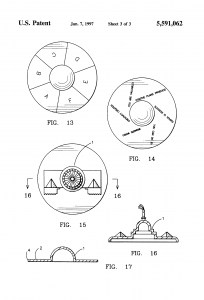
Catherine Hattinger’s 1997 Patent for her “Spinning De-Stressor”
Something along those lines, indeed, appears to have been the motivation for Hettinger’s original “Spinning De-stressor Finger Toy” as she called it. According to one story, it was the discovery, on a visit to her sister in Israel, of young boys throwing rocks at police officers that turned her mind to soothing toys.
Closer investigation later revealed that her patent, for a device shaped like a small rubbery sombrero designed to spin without moving parts on the tip of a child’s finger, almost certainly would not have qualified as prior art for today’s fidget spinner. The key part of the modern fidget spinner is that central, near-frictionless ball-race that gives the toy an uncanny aura of perpetual motion.
Despite the widespread claims from the many manufacturers of Fidget Spinners, no peer-reviewed studies have produced evidence that these gizmos help distracted children or adults to focus. But this would prove to be no deterrent to the arrival of the next big thing—the Fidget Cube.
The Fidget Cube
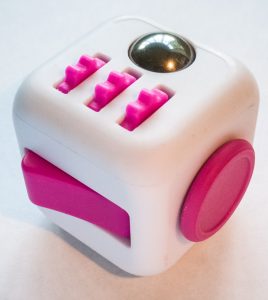 Hettinger’s attempt to revive her original spinning toy with a Kickstarter project that launched in May 2016 attracted fewer than a thousand backers. By June 18 of this year it had failed, falling more than $9,000 short of its $23,990 goal.
Hettinger’s attempt to revive her original spinning toy with a Kickstarter project that launched in May 2016 attracted fewer than a thousand backers. By June 18 of this year it had failed, falling more than $9,000 short of its $23,990 goal.
Starkly contrasting with this was a slightly later Kickstarter project opened by a start-up called Antsy Labs in August of 2016 in the wake of the snowballing Fidget Spinner Craze. The Fidget Cube quickly vacuumed up funds from 150,000 investors, becoming one of the all-time top ten Kickstarter success stories.
A successful fund-raising, yes. But production and delivery were another matter. Early backers expecting delivery of the final product in time for Christmas 2016 read this on the Kickstarter Website:
“We need to let you know that we discovered an issue that we had to make a tough call on. It’s an issue that many possibly wouldn’t have noticed, but it’s one that a person who uses their Fidget Cube often would probably notice over time and with heavy use. We had to make the difficult decision to briefly pause shipping in the name of quality. Typically this wouldn’t be too big of an issue but with the holidays and a tight deadline it has made a greater impact.
Instead of the Fidget Cube, early backers received “a small collection of graphics you can use to add to a Christmas/Hanukkah/holiday/birthday card”. Those with access to a 3D printer were also offered “a printable gift of sorts”.
It was a mess. The “issue”, reportedly, was that when the Antsy Labs team arrived in China to collect their first—large—shipment, flaws they had already pointed out in the prototype were still present in the bulk final product. Refusing to pay the manufacturer the outstanding balance, Antsy Labs was left without product to deliver and an increasingly agitated bunch of customers.
By February of this year nothing had been resolved. A keen backer commented on The Verge Website :
Xris Brown
I backed this project in early September with a December delivery… After update after update that fidget cubes would be shipping soon… and now we’re in February still without. No delivery, no shipping confirmation yet.I’m disappointed this product hasn’t been managed better. It looks like a great product. Execution has been lacking.
Posted on Feb 7, 2017 | 5:59 PM
Among others, it attracted the attention of a young entrepreneur, who, although only 24 years old, already had previous experience of the lucrative possibilities of the “knockoff” market. Tapping into the sizeable fortune he’d already made by copy-catting an idea for an inflatable air lounger that had gained a lot of traction on the Indiegogo crowd-funding Website, he wired $3,650 to a Shenzhen factory. Within weeks he received a delivery of 1,000 plastic toy cubes that looked identical to the still unrealised Kickstarter product.
He called it the “Stress Cube”. They sold for $19.99 each, at a rate of 100 a day. CNBC reports that the follow-up order, for 15,000, had peak sales of about 500 a day. And the Antsy Labs Fidget Cube was still not shipping.
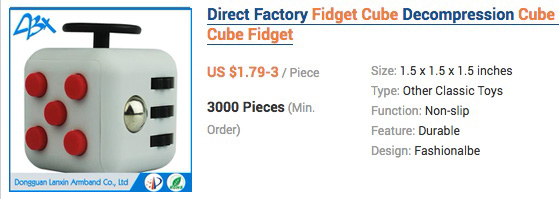
Dongguan Lanxin Armband Co Ltd is one of the myriad Alibaba factories. Its Fidget Cubes cost less than $2 each for a 3000 piece order and it claims to be able to produce 20,00 pieces a day.
The Stress Cube was only one of the Fidget Cube knock-offs. It seems unlikely that the manufacturer originally approached by Antsy Labs simply landfilled the rejected order. There’s every chance that those Fidget Cubes judged unworthy by the Americans joined others flooding the market over the 2016 Christmas period and beyond.
How many others? Alibaba is a massive Chinese e-commerce company, originally founded to link the vast network of small and large Chinese factories to business customers worldwide. In January of this year CNBC reported that a search on the Alibaba Website for “Fidget Cube” showed more than 13,000 manufacturer listings.
Antsy Labs Fights Back
Derived, probably, from the age-old phase “ants in his pants”, the word “antsy” has been adopted by American informal speech to mean “restless and fidgety”, and, by extension, “stressed to the point of violence”.
 While the word might well describe many of its by this time very impatient customers, the company’s execs appeared surprisingly laid back. (Although, maybe, furiously fiddling with their prototype Fidget Cubes under their desks). Co-founder Mark McLachlan told CNBC that competition from knockoffs was simply “the nature of the beast.” Just ensure that the genuine article you’re delivering is a much better product, he said.
While the word might well describe many of its by this time very impatient customers, the company’s execs appeared surprisingly laid back. (Although, maybe, furiously fiddling with their prototype Fidget Cubes under their desks). Co-founder Mark McLachlan told CNBC that competition from knockoffs was simply “the nature of the beast.” Just ensure that the genuine article you’re delivering is a much better product, he said.
Delivering? But when?
By May of this year the Kickstarter investors were getting really antsy. With still nothing to distribute, the campaign had closed and many of the punters reported they were getting no reply to their urgent queries.
But behind the scenes deals were being done. In what appears to be a hasty exit strategy, Antsy Labs sold its worldwide rights and name to the Chinese toy company Zuru. In the second week in May Zuru announced that over the coming months it would be manufacturing the Fidget Cube™, and distributing it to major retailers in the United States, Canada and other countries.
That ™ was not insignificant. Zuru’s launch plan included a strenuous effort to combat the copycat knockoffs. Zuru COO Anna Mowbray warned: “One critical element for us is to now protect the Antsy Labs invention and concept by ensuring they are not undercut by cheap, terrible quality knock-offs… We will… look into all avenues to vigorously protect this item both in the USA, Canada and internationally.”
So the Fidget Cube lives on. However, not every aspect of Zuru’s vigorous new marketing strategy brought joy to its original Kickstarter backers. In keeping with its self-styled “disruptive” approach to the market, Zuru considerably undercut the Kickstarter price. One early backer, who by June had been lucky enough eventually to receive his Kickstarter product, wrote in the Reddit Fidget Cube forum:
I was at a toys r us yesterday and… looked at [the Fidget Cubes] because I thought they were some knock off brand possibly. Saw that they were the Zuru by antsy. Saw that the case was almost identical to mine and it had the antsy labs logo on it.
Ive only had mine for a few weeks maybe, and I was a bit upset that I paid so much more for mine from Kickstarter.
Hands On the Fidget Spinner and Cube
Well, fingers, really. Tested Technology tries to live up to its name, although we’re only too conscious we lack the dexterity of finger artist PNUT. We certainly did put Zuru’s Fidget Spinner and Fidget Cube through its paces to the best of our ability.
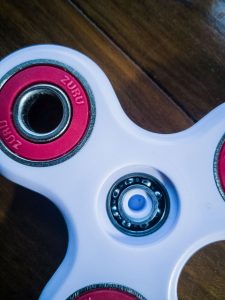
The central cap is removable, exposing the ball-race.
Unlike cheaper versions we’ve explored, Zuru’s own Fidget Spinner is certainly smoother and spins longer, thanks to its high-quality ball-race. At the time of writing Argos is selling Zuru’s Spinner in the UK for £4.99. You can pay more, of course (a lot more—prices begin to top out at around $1,000 for the keenest, richest fans), and the expensive ones may have ceramic, self-lubricating ball-races that can spin for over four minutes without a trace of wobble.
The Zuru Spinner isn’t in this class. It will give you a decent two minutes plus spin time, which should be enough to satisfy any except the hardened aficionado. As a bonus, each of the three wings also had an embedded ball-race, so you can swing it around by any of these.
The Fidget Cube is of course the central attraction here. You can pick the genuine article up for a gnat’s whisker less than a tenner from Amazon. Where, despite Zuru’s promise to defend its intellectual property, it competes with dozens of knock-offs, some of which Amazon will deliver for less than a fiver.
Although the Cube’s proportions give it rather more presence in your pocket than the slim Spinner, it nestles nicely in the crook of your finger and can be twirled, stroked and clicked as unobtrusively or as ostentatiously as you choose.
Those of a touchy-feely inclination will find much more variety in the Cube than the Spinner. Each of the six sides presents a different proposition. You have a flat, slidey joystick; a clicking rocker switch; a rotating dial; and a dice-like array of five push buttons, three of them clickers and two silent. There’s also a double bonus side with a set of three clicking rotating cog wheels surmounted by a steel roller ball that’s spring-mounted and clickable.
Topping the bill is the Zen-inspired worry-stone facet. Nothing to roll, click or spin here. Just a subtle indentation in the surface you can stroke with your thumb.
Conclusion
Well…
Perhaps I’m not the fidgety type. If you are, I can see how you might enjoy these things. For me, the—er—worrying thing is that neither of these devices actually does anything. You spin, you roll, you click… and nothing actually happens. Perhaps I’m too used to switches that switch things on or off.
But maybe, in a world now drowning in technology, that’s the point. The pressing of a button for its own sake. Rolling a wheel that does nothing more than just roll the wheel. Action without consequences. The journey is the reward.
Which would make that Zen-like, no-moving-parts, worry-stone facet of the Fidget Cube the apotheosis of all wisdom. The sound of one thumb stroking.
I’ll need to work on this.
Chris Bidmead

